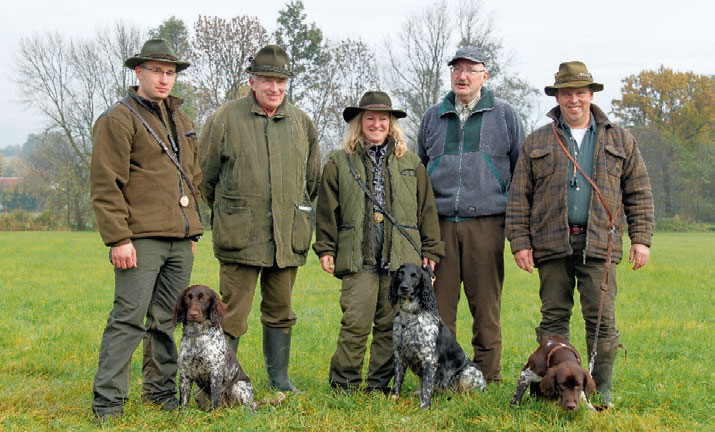by author and photographer: dr. Christine Miller
Courtesy of the magazine PIRSCH 24/2010
Responsible dog breeding has long since burst the country’s borders. More and more breeders want to expand the base of their hunting breed, without sacrificing high performance standards. In a united Europe that would actually be quite easy – if there were comparable examinations in the individual countries. The breed societies of the Great and Small Münsterländer have embarked on this journey: the ” International Münsterländerprüfung IMP ” has now passed their baptism of fire: Since 2007, a member committee of “KlM International” has had representatives of the breed societies in Germany, Austria, France, Netherlands and Czech Republic to an international examination regulations (PO). Invited was also the VGM. From October 22 to 24, 2010, eight teams from the countries mentioned in Altheim (Austrian Innviertel) competed for a test run. The low-rainforest areas offered excellent conditions for testing the “usefulness” of the PO.
Bernd-Dieter Jesinghausen, head of the examination and chairman of the “Kleine Münsterländer International” association, summed up the goal: “We want to create an exam that is close to the game and practical and that takes into account criteria that are relevant to the law can not be influenced so much by dressing. “Karl Wichmann from the Association of the Great Munsterlander agreed with his colleagues from the” little ones “:” Today we are always selling dogs abroad, but can not fall back on these animals later. Association tests in neighboring countries are just too different. That’s why we need an examination regulation that can be carried out anywhere and makes sense hunting everywhere. “
The dogs were tested in three groups of subjects: The forest work included an overnight track, free search for lost and bringing wild game, browsing and bush. At the water, they had to search for lost trees in abundant waters, browse behind the living duck and bring them up and show their projecting characteristics in the field. In addition, obedience, hunting skills, teamwork and being were assessed.
With pair search
At least as important as the work of the dogs and their guides was the discussion in Altheim, whether the tested subjects were necessary or sufficient for the evaluation of the breeding characteristics of a dog. Why not a train? “The train is a pure obedience thing. Anyone who works well with his dog can use the train, “says one participant. “Nose, concentration, willingness to foster and willingness to fetch can be evaluated in the free search for lost well and close to hunting.”
By contrast, everyone agreed on the importance of the pair search – two dogs work simultaneously in a field without hindering each other. “The pair search is very practical and forces the dogs to adjust to each other. The character and temperament of the four-runners are wonderfully comparable, “Jesinghausen agrees. “We will certainly take the pair search as an integral part of the International Examination”.
From the experiences of the test run, the examination committee will adapt the PO to the next “test test”. In October 2011, the Landesgruppe Nordbayern will carry out the second “IMP” of KlM Germany. Then the revised examination regulations go into the national breeding associations. If approved there, the next step is FCI approval. Only then is an “International Münsterländerprüfung” also officially registered in the pedigree of the dogs.
A long way, which did not detract from the joy of the dog handlers in Altheim. They had put themselves and their dogs out of interest for the two-day exam. The result was impressive: in addition to two second prizes, a first prize was awarded five times. The two top dogs, the big Münsterlanders “Dasty vom Luxriegel” with their leader Josef Prenner from Austria and “Frena vom Allgäuer Tor”, led by Milica Urbach from Bavaria, were even tied (with 276 + 16 points).Since in this case the younger dog is given preference, Milica Urbach and her bitch were the lucky winners of the day.All “Münsterländer” have won on the way to an international working test.

No “kinship”
One might think that the “Kleine Münsterländer” is a pygmy edition of the “Great Münsterlander”. That is not so! The “Kleine Münsterländer” (formerly known as “Heidewachtel”) is genetically no closer related to the “Great Munsterlander” than to all other long-haired continental breeds. If one is allowed to believe Edmund Lons, a then very well-known breeder of this breed, then one of his direct ancestors is the “Breton Pointing Dog”. By contrast, the “Great Munsterlander” is actually nothing more than a black and white version of the “German Longhair”. Only about 70 years ago, the German Longhair Federation closed the “black and white” of further entries in his studbook, which led to the lovers of this color variety together and according to the preferred breeding area of their dogs this “Great black and white Münsterländer “called. They founded their own club, dedicated to the breeding of this interesting “new breed”. BK
Info
www.klm-international.info
www.grossermuensterlaender.de
this report as PDF: Zeitungsartikel Pirsch 2010 Frau Dr. Miller
